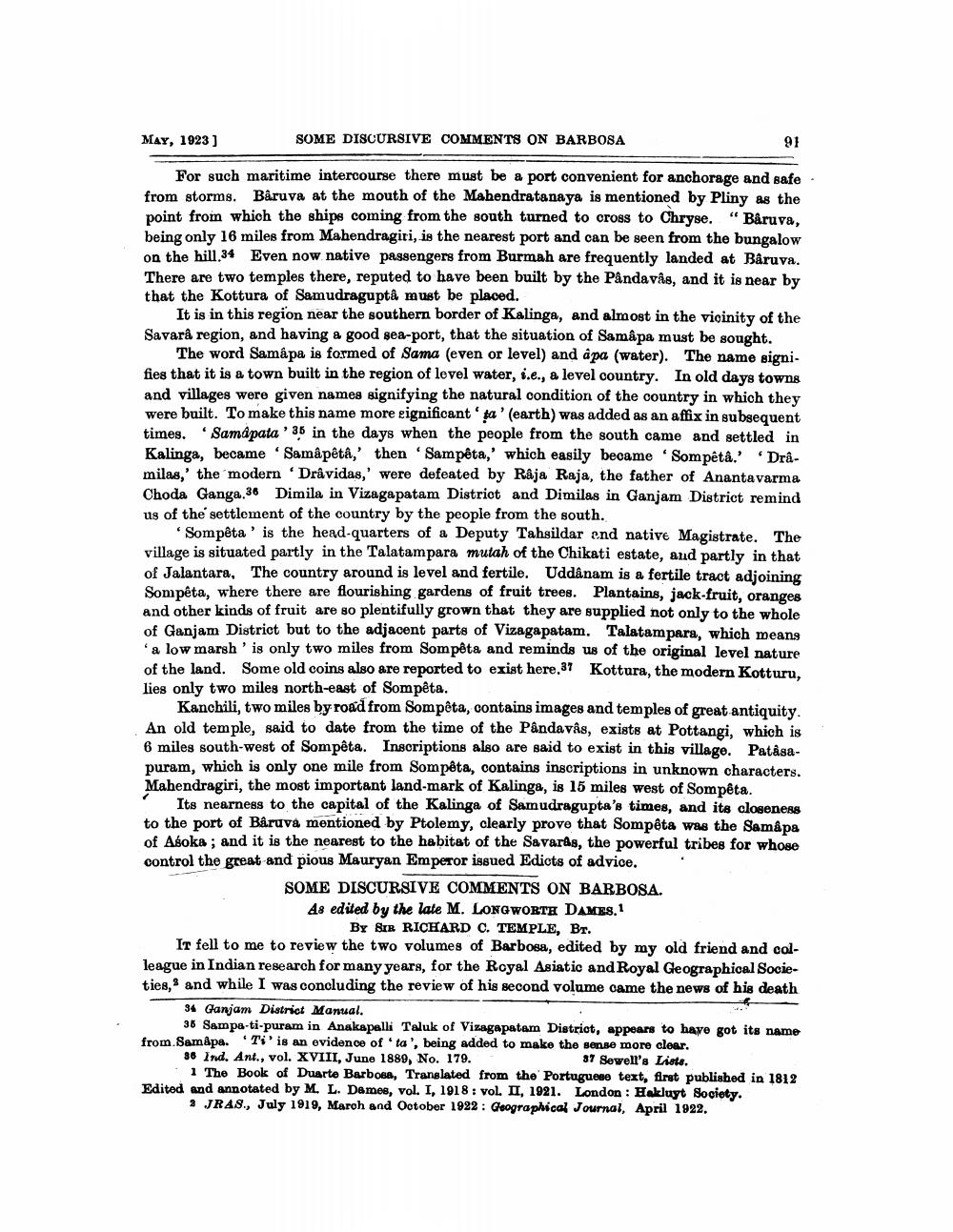________________
MAY, 1923]
SOME DISCURSIVE COMMENTS ON BARBOSA
For such maritime intercourse there must be a port convenient for anchorage and safe from storms. Bâruva at the mouth of the Mahendratanaya is mentioned by Pliny as the point from which the ships coming from the south turned to cross to Chryse. "Bâruva, being only 16 miles from Mahendragiri, is the nearest port and can be seen from the bungalow on the hill.34 Even now native passengers from Burmah are frequently landed at Bâruva. There are two temples there, reputed to have been built by the Pândavâs, and it is near by that the Kottura of Samudraguptâ must be placed.
It is in this region near the southern border of Kalinga, and almost in the vicinity of the Savarâ region, and having a good sea-port, that the situation of Samâpa must be sought.
"
The word Samâpa is formed of Sama (even or level) and apa (water). The name signifies that it is a town built in the region of level water, i.e., a level country. In old days towns and villages were given names signifying the natural condition of the country in which they were built. To make this name more significant ta' (earth) was added as an affix in subsequent times. Samapata' 35 in the days when the people from the south came and settled in Kalinga, became Samâpêtâ,' then 'Sampêta,' which easily became Sompêtâ.' 'Drâmilas,' the modern Drâvidas,' were defeated by Raja Raja, the father of Ananta varma Choda Ganga,36 Dimila in Vizagapatam District and Dimilas in Ganjam District remind us of the settlement of the country by the people from the south.
C
Sompêta' is the head-quarters of a Deputy Tahsildar and native Magistrate. The village is situated partly in the Talatampara mutah of the Chikati estate, and partly in that of Jalantara, The country around is level and fertile. Uddânam is a fertile tract adjoining Sompêta, where there are flourishing gardens of fruit trees. Plantains, jack-fruit, oranges and other kinds of fruit are so plentifully grown that they are supplied not only to the whole of Ganjam District but to the adjacent parts of Vizagapatam. Talatampara, which means 'a low marsh' is only two miles from Sompêta and reminds us of the original level nature of the land. Some old coins also are reported to exist here.37 Kottura, the modern Kotturu, lies only two miles north-east of Sompêta.
Kanchili, two miles by road from Sompêta, contains images and temples of great antiquity. An old temple, said to date from the time of the Pândavâs, exists at Pottangi, which is 6 miles south-west of Sompêta. Inscriptions also are said to exist in this village. Patasapuram, which is only one mile from Sompêta, contains inscriptions in unknown characters. Mahendragiri, the most important land-mark of Kalinga, is 15 miles west of Sompêta.
Its nearness to the capital of the Kalinga of Samudragupta's times, and its closeness to the port of Bâruva mentioned by Ptolemy, clearly prove that Sompêta was the Samâpa of Asoka; and it is the nearest to the habitat of the Savaras, the powerful tribes for whose control the great and pious Mauryan Emperor issued Edicts of advice.
91
SOME DISCURSIVE COMMENTS ON BARBOSA. As edited by the late M. LONGWORTH DAMES.1 BY SIR RICHARD C. TEMPLE, BT.
Ir fell to me to review the two volumes of Barbosa, edited by my old friend and colleague in Indian research for many years, for the Royal Asiatic and Royal Geographical Societies, and while I was concluding the review of his second volume came the news of his death
34 Ganjam District Manual.
35 Sampa-ti-puram in Anakapalli Taluk of Vizagapatam District, appears to have got its name from Samapa. Ti' is an evidence of ta', being added to make the sense more clear. 37 Sewell's Lists.
36 Ind. Ant., vol. XVIII, June 1889, No. 179.
1 The Book of Duarte Barbosa, Translated from the Portuguese text, first published in 1812 Edited and annotated by M. L. Dames, vol. I, 1918: vol. II, 1921. London: Hakluyt Society.
2 JRAS., July 1919, March and October 1922: Geographical Journal, April 1922.




